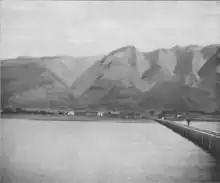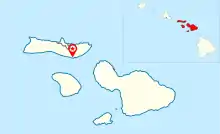Kamalō Sugar Plantation
The Kamalō Sugar Plantation (also: Kamaloo, Kamalo) was a sugarcane plantation and mill located in Kamalō, Molokai, Kingdom of Hawaii.[1] It was the oldest sugar plantation and mill established on Molokai[Note 1] and ceased operations before the 1906 founding of the California and Hawaiian Sugar Company.[2]
 | |
| Type | Private |
|---|---|
| Industry | Sugarcane |
| Founded | 1873 in Kamalō, Molokai, Kingdom of Hawaii |
| Founder | John C. McColgan (1814-1890) |
| Defunct | 1891 |
| Successor | Kamalo Sugar Company, Ltd. |
Key people |
|
History

The Kamalō Sugar Plantation was founded by Irish-born businessman John C. McColgan (1814-1890) in 1873. In July of that year, he was reported to have leased a 4,000-acre tract of land from the late King Kamehameha V's estate that was located between Kaunakakai and Kalua‘aha.[3] The mill and plantation were managed by McColgan's cousins, the Irish-born brothers Hugh McCorriston (1836-1926) and Daniel McCorriston (1840-1927).[4][5]
The mill equipment for the Kamalō Sugar Plantation was the same as used at McColgan's sugarcane plantation located in Waiau, O‘ahu. [3]
The Kamalō Sugar Plantation began exporting sugar to California in the 1880s, with a reported shipment of 353 bags aboard the SS Mariposa (1883) in September 1884.[6]
Upon McColgan's death in 1890, ownership of the Kamalō Sugar Plantation passed in part to the McCorriston brothers.[7]
The Fire of 1891
On August 7, 1891, the Kamalō Sugar Plantation burned to the ground due to unknown causes.[7] The mill and plantation were insured for $25,000, (~$696,294 in 2021) and cattle turned onto the land for ranching.[8]
Revival
In 1897, the McCorriston brothers began discussing reviving the Kamalō Sugar Plantation.[8] In 1899, the brothers sold their land to Frank Hustace, J.J. Egan, and Hugh's stepson Frank Hudson Foster, who incorporated under the name Kamalō Sugar Company, Limited. [9]
Notes
- Of the three plantations and mills in operation on Molokai in 1880, Moanui Sugar Mill and Plantation was established in 1875 and Kalae Sugar Plantation was established in 1876.
References
- Pukui, Mary Kawena, Samuel H. Elbert and Esther T. Mookini (1974). Place Names of Hawaii (Revised & expanded ed.). Honolulu, HI: The University Press of Hawaii. p. 150. ISBN 978-0-8248-0524-1.
{{cite book}}: CS1 maint: multiple names: authors list (link) - "Local and General". The Pacific Commercial Advertiser. 12 August 1891. Retrieved 10 June 2019.
- "New Sugar Plantation". The Hawaiian Gazette. 23 July 1873. Retrieved 10 June 2019.
- 1880-1881: The Hawaiian Kingdom Statistical and Commercial Directory and Tourist's Guide. Honolulu; San Francisco: George Bowser & Co. 1880. p. 411. hdl:10524/19432.
- 1888: Husted's Directory of Honolulu and the Hawaiian Territory. Honolulu; San Francisco: George Bowser & Co. 1888. p. 496. hdl:10524/12272.
- "For San Francisco, per Mariposa, Sept 15". The Pacific Commercial Advertiser. 16 September 1884. Retrieved 10 June 2019.
- "Sugar Mill Burned Down". Evening Bulletin. 11 August 1891. Retrieved 10 June 2019.
- "Will Develop Molakai". The Hawaiian Star. 26 May 1897. Retrieved 10 June 2019.
- "At Kamalo Again". The Pacific Commercial Advertiser. 22 April 1899. Retrieved 10 June 2019.